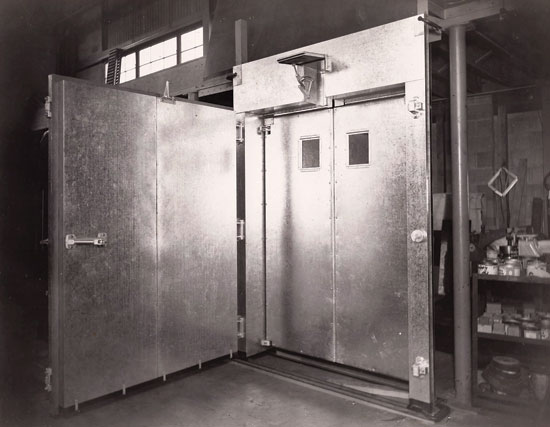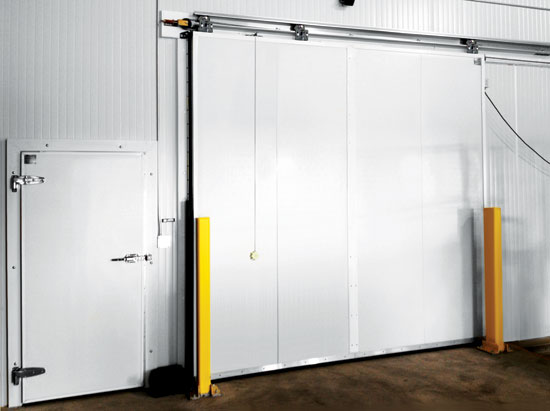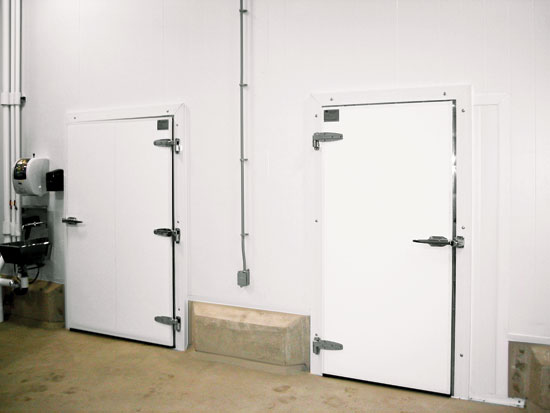Cold Storage Door Systems
Trade Associations
The wave of inventiveness and creativity touched off by the Industrial Revolution included the development of mechanical means to cool a defined space or box. This became popular enough that by 1904 the American Society of Refrigeration Engineers (ASRE) was founded initially for the purpose of promoting the technology of refrigeration for appliances, railroad cars, trucks, etc. In 1959 they merged with the American Society of Heating and Air-Conditioning Engineers (ASHAE) which was actually founded in 1894—10 years earlier than ASRE—to form the American Society of Heating, Refrigerating and Air-Conditioning Engineers (ASHRAE). We know ASHRAE today as a large, international organization with a mission to advance the arts and sciences of heating, ventilating, air-conditioning, and refrigeration. While we may think of them only for the HVAC systems in buildings, the “R” for refrigeration has clearly long been a core part of what these engineers and other members do. In fact their core publications include the 2010 ASHRAE Handbook: Refrigeration, which covers the design of refrigeration equipment and systems for applications other than human comfort including cooling, freezing, and storing food; industrial applications of refrigeration; and low-temperature refrigeration.
Not surprisingly, other organizations were created and grew during the same timeframe as ASHRAE. The International Association of Refrigerated Warehouses (IARW) came into existence in 1891 when a number of conventional warehousemen began storing perishable food to meet market demand. They soon realized the increased challenge and complexity of operating temperature-controlled storage facilities compared to typical warehouses without temperature control. This organization has grown to the point where today, IARW aggressively promotes best practices in temperature-controlled warehousing. As an organization they promote relevant research, industry benchmarking, member networking, and education for members and the public. They are politically active in that they also advise members of legislation and regulations affecting the food industry while assisting members in complying with U.S. and international regulations. In recent times, they have also become quite focused on l ogistics in terms of moving, shipping, or distributing the goods that they are storing into and out of those warehouses.
As the design and construction of cold storage facilities became more focused on how to best insulate and construct these facilities, those involved in that work saw the need to come together as well. In 1978, a small group of insulation contractors began to discuss creating an association representing contractors who serve the specific needs of the cold storage industry. Within a year, the National Association of Cold Storage Insulation Contractors was incorporated, its founding Board of Directors was named, and its purpose and objectives were defined. In 1987, the name was changed to the International Association of Cold Storage Contractors as they expanded to include members from the UK and elsewhere. In 2002, another name change was made to create the current International Association for Cold Storage Construction (IACSC) in order to invite a broader membership base while providing equal status for all. Today, they are made up of general contractors, cold storage construction contractors, and suppliers all focused on the best means for constructed refrigerated facilities.

Photo courtesy of Chase Doors
The development of cold storage facilities and the doors that go on them has evolved from the 1800s up to the present.
In 2005 the IARW and IACSC began to see the benefit of working with other related trade organizations. These included The World Food Logistics Organization (WFLO) whose members were focused on the logistics portion of cold storage and distribution. Together, they also recognized the benefit of teaming with the International Refrigerated Transportation Association (IRTA) that provided refrigerated trucking and other shipping means. By the close of 2006, the boards of all four of these organizations created the Global Cold Chain Alliance (GCCA), an umbrella organization creating partnerships among associations, governments, institutions, and private companies spanning each link of the cold food storage and distribution chain. GCCA officially launched in April 2007 and now acts as the platform for communication, networking, and education, serving as the focused voice of the cold chain industry. Many members of any one of these four organizations under the GCCA umbrella also enjoy joint membership with one or more of the others.
Modern Cold Storage Facilities
Designing cold storage facilities today involves a distinction between general building construction and cold storage construction. A building may contain some cold storage inside it which typically means that the cold storage enclosure is made from pre-fabricated sandwich panels with spray foam between metal faces. These panels then determine the size, height, and thermal performance of the cold storage system with the surrounding building which is fulfilling other purposes. In cases where the entire building is the cold storage facility, it may well be that the walls, roof, and floor of most or even all of the building are the critical enclosing components and they must be designed and specified accordingly.
Beyond the distinction of using a freestanding internal enclosure or a building enclosure, cold storage in general falls into two overall categories identified by size. A small facility is defined as one under 3,000 square feet even though this is equivalent to the size of a house. In practice these small enclosures range in size from a walk-in refrigerator or freezer of a few hundred square feet typically found in restaurants up to larger-capacity units found in supermarkets or institutions with a large food preparation operation. From a regulatory standpoint, these smaller walk-in facilities are subject to the Energy Independence and Security Act of 2007 (EISA). This comprehensive legislation added to and amended the previous Energy Policy and Conservation Act (EPACT) first passed in 1975 and revised several times through 2005. Part of the provisions of these current regulations include a definition of the terms “walk-in cooler” and “walk-in freezer” which mean “an enclosed storage space refrigerated to temperatures, respectively, above, and at or below 32 degrees Fahrenheit that can be walked into, and has a total chilled storage area of less than 3,000 square feet.”
The EISA legislation goes on to address some very specific aspects regarding the construction of any walk-in cooler or walk-in freezer manufactured on or after January 1, 2009. First they must have automatic door closers that firmly close all walk-in doors although there is an exception for doors wider than 3 feet 9 inches or taller than 7 feet. Second, they must have strip doors, spring hinged doors, or another method of minimizing infiltration when doors are open. When it comes to the construction of the units, they must contain wall, ceiling, and door insulation of at least R-25 for coolers and R-32 for freezers, except for glazed portions of doors or structural members. Floors of freezers must be insulated to at least R-28. There are also specific provisions for the refrigeration equipment types, and efficiency in the interest of saving or reducing electrical energy used. Nonetheless, the legislation clearly recognizes the significance of the basic construction of the enclosure and attention to detail at the doors in terms of conserving energy.

Photo courtesy of Chase Doors
Cold storage doors are custom fabricated in different sizes and types with multiple options available.
Large facilities over 3,000 square feet are not covered by the provisions above, but they are subject to energy efficiency standards for buildings when they comprise most or all of a warehouse or similar building. This is particularly important when you consider that refrigerated spaces are being controlled to an interior temperature of 34-36 degrees Fahrenheit while freezer storage is controlled to 0 to 20 degrees Fahrenheit. That means as a practical matter, these larger facilities likely want to meet the same or better R-values as stated above to create efficiency in energy use and to control operational costs. It is common for these large facilities to bump up the R-values to R-32 for refrigerated storage and R-48 for freezers. It is also likely that a large facility will require multiple doors that are larger in size to allow not only walk-in operation but drive-in operation of forklifts or other equipment. The best rule of thumb in this case is that these doors should be made to match the thickness and performance of the walls (e.g. R-32 and R-48). Beyond that, since these doors are the only source of thermal interruption and usually the only operable item, it is worth spending time to focus on the details of the options, types, and fabrication of these doors.
Swinging Doors
Single- and double-panel swing doors are commonly used for walk-in applications where strong environmental control is necessary. Swinging cooler and freezer doors provide time-proven performance for new or existing applications and are suitable for both interior and exterior applications. Typically they are used for personnel walk-in doors and are sized accordingly, but much larger swinging doors are possible that can allow machinery or equipment to pass through as well. Because the door swings out into the path of travel, the facility design needs to account for both this door swing and the travel clearances required for people or equipment when entering/exiting.

Photo courtesy of Chase Doors
Swinging cold storage doors can be sized and located for people to access readily on foot or with handheld carts.









